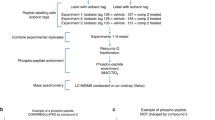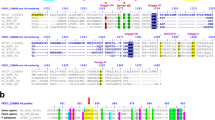Abstract
A mitogen-activated protein kinase (MAPK), Pfmap2, has been identified in Plasmodium falciparum. However, its bona fide activator remains elusive as no MAPK kinase (MAPKK) homologues have been found so far. Instead, Pfnek3, a NIMA (never in mitosis, Aspergillus)-related kinase, was earlier reported to display a MAPKK-like activity due to its activating effect on Pfmap2. In this study, the regulatory mechanism of Pfnek3 was investigated. Pfnek3 was found to possess a SSEQSS motif within its activation loop that fulfills the consensus SXXXS/T phospho-activating sequence of MAPKKs. Functional analyses of the SSEQSS motif by site-directed mutagenesis revealed that phosphorylation of residues S221 and S226 is essential for mediating Pfnek3 activity. Moreover, via tandem mass-spectrometry, residue T82 was uncovered as an additional phosphorylation site involved in Pfnek3 activation. Collectively, these results provide valuable insights into the potential in vivo regulation of Pfnek3, with residues T82, S221 and S226 functioning as phospho-activating sites.






Similar content being viewed by others
References
World Health Organization (2008) World Malaria Report 2008
Khan SM, Waters AP (2004) Malaria parasite transmission stages: an update. Trends Parasitol 20:575–580
Schramek H (2002) MAP kinases: from intracellular signals to physiology and disease. News Physiol Sci 17:62–67
Zhang Y, Dong C (2007) Regulatory mechanisms of mitogen-activated kinase signaling. Cell Mol Life Sci 64:2771–2789
Pearson G, Robinson F, Beers Gibson T, Xu BE, Karandikar M, Berman K, Cobb MH (2001) Mitogen-activated protein (MAP) kinase pathways: regulation and physiological functions. Endocr Rev 22:153–183
Doerig CM, Parzy D, Langsley G, Horrocks P, Carter R, Doerig CD (1996) A MAP kinase homologue from the human malaria parasite, Plasmodium falciparum. Gene 177:1–6
Graeser R, Kury P, Franklin RM, Kappes B (1997) Characterization of a mitogen-activated protein (MAP) kinase from Plasmodium falciparum. Mol Microbiol 23:151–159
Dorin D, Alano P, Boccaccio I, Ciceron L, Doerig C, Sulpice R, Parzy D (1999) An atypical mitogen-activated protein kinase (MAPK) homologue expressed in gametocytes of the human malaria parasite Plasmodium falciparum. Identification of a MAPK signature. J Biol Chem 274:29912–29920
Dorin-Semblat D, Quashie N, Halbert J, Sicard A, Doerig C, Peat E, Ranford-Cartwright L (2007) Functional characterization of both MAP kinases of the human malaria parasite Plasmodium falciparum by reverse genetics. Mol Microbiol 65:1170–1180
Ward P, Equinet L, Packer J, Doerig C (2004) Protein kinases of the human malaria parasite Plasmodium falciparum: the kinome of a divergent eukaryote. BMC Genomics 5:79
Anamika K, Srinivasan N (2007) Comparative kinomics of Plasmodium organisms: unity in diversity. Protein Pept Lett 14:509–517
Dorin D, Le Roch K, Sallicandro P, Alano P, Parzy D, Poullet P, Meijer L, Doerig C (2001) Pfnek-1, a NIMA-related kinase from the human malaria parasite Plasmodium falciparum Biochemical properties and possible involvement in MAPK regulation. Eur J Biochem 268:2600–2608
Dorin D, Semblat JP, Poullet P, Alano P, Goldring JP, Whittle C, Patterson S, Chakrabarti D, Doerig C (2005) PfPK7, an atypical MEK-related protein kinase, reflects the absence of classical three-component MAPK pathways in the human malaria parasite Plasmodium falciparum. Mol Microbiol 55:184–196
O’Connell MJ, Krien MJ, Hunter T (2003) Never say never. The NIMA-related protein kinases in mitotic control. Trends Cell Biol 13:221–228
Lye YM, Chan M, Sim TS (2006) Pfnek3: an atypical activator of a MAP kinase in Plasmodium falciparum. FEBS Lett 580:6083–6092
Low H, Lye YM, Sim TS (2007) Pfnek3 functions as an atypical MAPKK in Plasmodium falciparum. Biochem Biophys Res Commun 361:439–444
Schwede T, Kopp J, Guex N, Peitsch MC (2003) SWISS-MODEL: an automated protein homology-modeling server. Nucleic Acids Res 31:3381–3385
Ohren JF, Chen H, Pavlovsky A, Whitehead C, Zhang E, Kuffa P, Yan C, McConnell P, Spessard C, Banotai C, Mueller WT, Delaney A, Omer C, Sebolt-Leopold J, Dudley DT, Leung IK, Flamme C, Warmus J, Kaufman M, Barrett S, Tecle H, Hasemann CA (2004) Structures of human MAP kinase kinase 1 (MEK1) and MEK2 describe novel noncompetitive kinase inhibition. Nat Struct Mol Biol 11:1192–1197
Guex N, Peitsch MC (1997) SWISS-MODEL and the Swiss-PdbViewer: an environment for comparative protein modeling. Electrophoresis 18:2714–2723
Keller A, Nesvizhskii AI, Kolker E, Aebersold R (2002) Empirical statistical model to estimate the accuracy of peptide identifications made by MS/MS and database search. Anal Chem 74:5383–5392
Nesvizhskii AI, Keller A, Kolker E, Aebersold R (2003) A statistical model for identifying proteins by tandem mass spectrometry. Anal Chem 75:4646–4658
Zheng CF, Guan KL (1994) Activation of MEK family kinases requires phosphorylation of two conserved Ser/Thr residues. EMBO J 13:1123–1131
Hanks SK, Hunter T (1995) Protein kinases 6. The eukaryotic protein kinase superfamily: kinase (catalytic) domain structure and classification. FASEB J 9:576–596
Huang W, Erikson RL (1994) Constitutive activation of Mek1 by mutation of serine phosphorylation sites. Proc Natl Acad Sci USA 91:8960–8963
Engh RA, Bossemeyer D (2001) The protein kinase activity modulation sites: mechanisms for cellular regulation—targets for therapeutic intervention. Adv Enzyme Regul 41:121–149
Johnson LN, Noble ME, Owen DJ (1996) Active and inactive protein kinases: structural basis for regulation. Cell 85:149–158
Pu RT, Xu G, Wu L, Vierula J, O’Donnell K, Ye XS, Osmani SA (1995) Isolation of a functional homolog of the cell cycle-specific NIMA protein kinase of Aspergillus nidulans and functional analysis of conserved residues. J Biol Chem 270:18110–18116
Acknowledgments
We are grateful to Professor Christian Doerig (University of Glasgow) for providing the plasmid carrying the Pfmap2 gene. We would also like to express our sincere gratitude to Dr. Manfred Raida, Ms Ee Kim Huey and Mr Li Rong (A*STAR Experimental Therapeutics Centre) for providing technical expertise in the LC-MS/MS analyses.
Author information
Authors and Affiliations
Corresponding author
Rights and permissions
About this article
Cite this article
Low, H., Chua, C.S. & Sim, TS. Regulation of Plasmodium falciparum Pfnek3 relies on phosphorylation at its activation loop and at threonine 82. Cell. Mol. Life Sci. 66, 3081–3090 (2009). https://doi.org/10.1007/s00018-009-0101-8
Received:
Revised:
Accepted:
Published:
Issue Date:
DOI: https://doi.org/10.1007/s00018-009-0101-8




